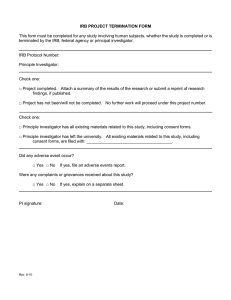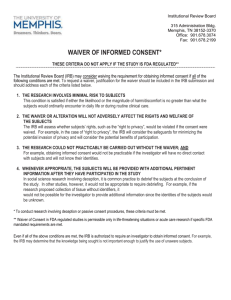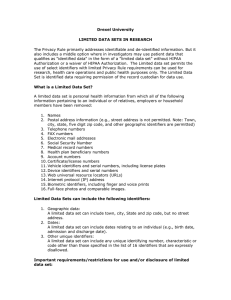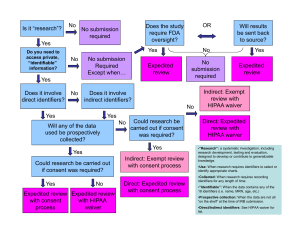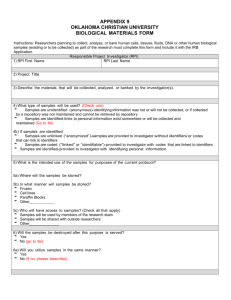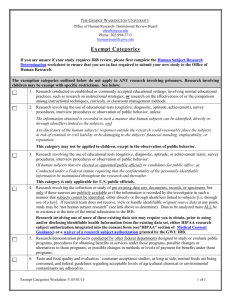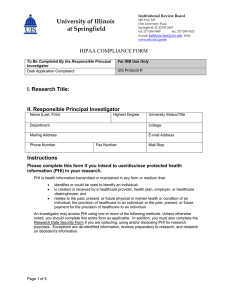Application for Case Reports and Case Studies DREXEL UNIVERSITY
advertisement
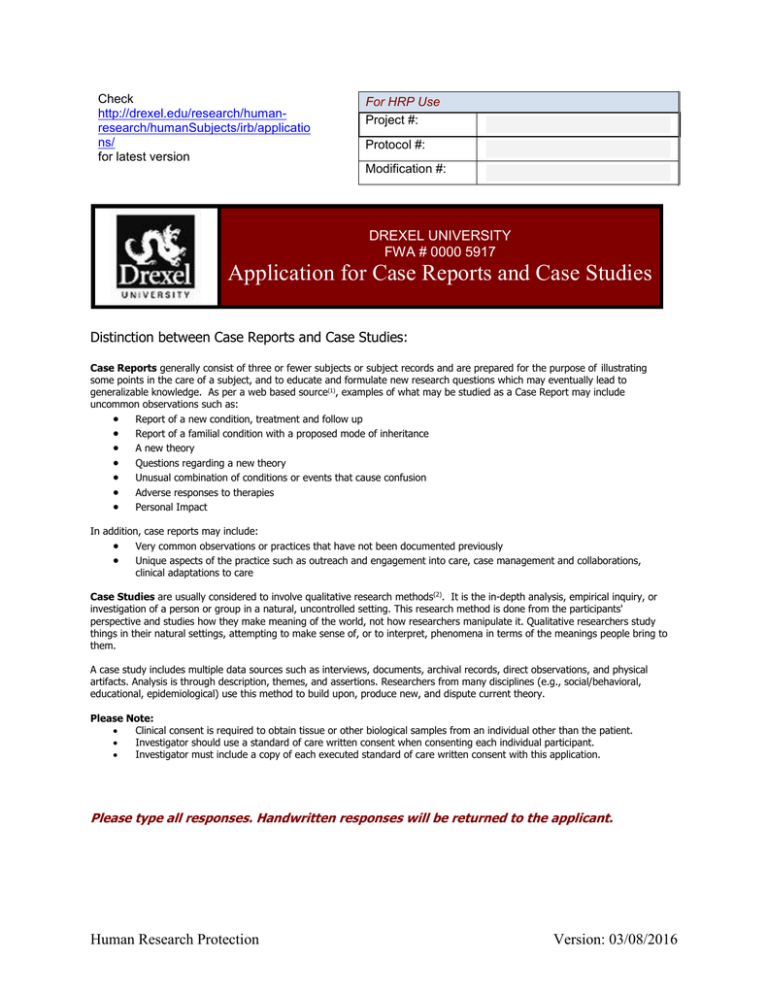
Check http://drexel.edu/research/humanresearch/humanSubjects/irb/applicatio ns/ for latest version For HRP Use Project #: Protocol #: Modification #: DREXEL UNIVERSITY FWA # 0000 5917 Application for Case Reports and Case Studies Distinction between Case Reports and Case Studies: Case Reports generally consist of three or fewer subjects or subject records and are prepared for the purpose of illustrating some points in the care of a subject, and to educate and formulate new research questions which may eventually lead to generalizable knowledge. As per a web based source(1), examples of what may be studied as a Case Report may include uncommon observations such as: Report of a new condition, treatment and follow up Report of a familial condition with a proposed mode of inheritance A new theory Questions regarding a new theory Unusual combination of conditions or events that cause confusion Adverse responses to therapies Personal Impact In addition, case reports may include: Very common observations or practices that have not been documented previously Unique aspects of the practice such as outreach and engagement into care, case management and collaborations, clinical adaptations to care Case Studies are usually considered to involve qualitative research methods(2). It is the in-depth analysis, empirical inquiry, or investigation of a person or group in a natural, uncontrolled setting. This research method is done from the participants' perspective and studies how they make meaning of the world, not how researchers manipulate it. Qualitative researchers study things in their natural settings, attempting to make sense of, or to interpret, phenomena in terms of the meanings people bring to them. A case study includes multiple data sources such as interviews, documents, archival records, direct observations, and physical artifacts. Analysis is through description, themes, and assertions. Researchers from many disciplines (e.g., social/behavioral, educational, epidemiological) use this method to build upon, produce new, and dispute current theory. Please Note: Clinical consent is required to obtain tissue or other biological samples from an individual other than the patient. Investigator should use a standard of care written consent when consenting each individual participant. Investigator must include a copy of each executed standard of care written consent with this application. Please type all responses. Handwritten responses will be returned to the applicant. Human Research Protection Version: 03/08/2016 I. PROJECT DETAILS AND SIGNATURE OF THE PRINCIPAL INVESTIGATOR 1.1 Project Title: Project Title: Sponsor: 1.2 Principal Investigator: Principal Investigator Name: Phone Number: Degree: Fax Number: E-mail address: Pager or Cell Number: Department: College or School: Position: Faculty / Staff / Investigator / Other (describe below): Other (describe your position): II. PROJECT INFORMATION 2.1 In the space below, please describe your project and what your proposal entails, (population to be studied, disease process, treatment, observation, possible significance of discovery) and its possible impact to the scientific community. 2.2. Number of patient records or data sources to be reviewed and examined? (If your project involves more than three (3) records, IRB review and approval may be required.) 2.3. Are subjects chosen from records, or does the information about the subjects that is gathered originate from a database or chart? 2.4. Has the source of data, information, or chart originated from your own department or unit? Yes No Yes No 2.5. Project start date: 2.6. Project completion date: 2.7. Provide the location where data records or information is stored or will be available. 2.8. Will you record any direct identifiers, names, addresses, telephone numbers, etc? Human Research Protection Yes No Version: 03/08/2016 If “Yes” explain why it is necessary to record findings with identifiers. If there is a coding system which you will use to protect against disclosure of these identifiers, please include the system in the box below. Also, describe the provisions you have taken to maintain confidentiality of data. Please Note: HIPAA regulations require authorization from the subject or waiver of authorization by the Privacy Board. If you intend to access medical records or a database that is inclusive of protected health information (PHI) and personal identifiers you MUST complete the HIPAA Waiver of Authorization request below. Complete the questions listed below to secure HIPAA Waiver of Authorization if you are faculty or staff from the Drexel University or a member of St. Christopher’s Hospital for Children, and you are collecting protected health information from medical charts. III. HIPAA WIAVER OF AUTHORIZATION Approval of waiver of authorization requires all questions form 3.1 – 3.9 to be appropriately answered. 3.1 Explain why the proposed research study is minimal risk 3.2 The waiver or alteration will not adversely affect the rights and welfare of the participants. Explain below how this is done. 3.3. The research could not practically be carried out without the waiver or alteration of waiver. Explain why below. 3.4 Whenever appropriate, research subjects will be provided with additional pertinent information on the research project after participation. Explain below how this is done. 3.5 Describe the reasons below why the consent form linking the subject to the research would result in potential harm or breach of confidentiality. (Note: if you are requesting waiver of consent for reasons other than linking the consent form to the subject, describe your justification below ) 3.6 The research could not practicably be carried out without access to and use of PHI. Explain why below. 3.7 Describe below your plan to destroy identifiers at the earliest opportunity consistent with conducting the research. If retention of identifiers is required for reasons of health, research or law, indicate where Human Research Protection Version: 03/08/2016 the identifiers will be stored or retained. 3.8 Describe your plan to adequately protect identifiers from improper use and disclosure. (Check all that apply and explain other protective measures you will use). a. Only authorized persons will be granted access. b. Only authorized persons may enter and view study data. c. Password and system IDs will not be shared. d. Physical security of computers and paper files will be maintained e. Adequate back-up plan is in effect. f. Staff is trained on the data entry system and importance of security procedures. g. Computers with the database will not be left unattended. a b c d e f g 3.9 Names of the Investigator or co-investigators and their training dates. You must complete both the CITI HIPS course as well as the Drexel Core modules for HIPAA & Medical Research and HIPAA & eSecurity training. Name Date 3.10 If applicable, the research collaborator from another covered entity has signed a Business Associate Agreement (BAA). Please attach a copy of BAA Name of Collaborating Entity Date of BAA Principal Investigator signature: ______________________________________ Date: Department Chair signature: ______________________________________ Date: Reviewed and approved as a Case Report or Case Study not requiring IRB approval. Date: Signature of Reviewer Reviewed and disapproved as a Case Study. Submit as a research proposal for IRB review. Signature of Reviewer Human Research Protection Date: Version: 03/08/2016 RETURN THIS APPLICATION FORM AND A COPY OF THE CASE STUDY TO HUMAN RESEARCH PROTECTION. Human Research Protection, 1505 Race Street, 7th Floor, Bellet Building, Philadelphia, PA 19102 For guidelines, go to: http://drexel.edu/research/human-research/humanSubjects/irb/applications/ For additional help please call 215-762-3944. References: 1. Burge SK. Writing A Clinical Case Report. Family and Community Medicine, The University of Texas Health Science Center at San Antonio site. 2004. [A PowerPoint presentation that can be reviewed in 15 minutes.] Available at http://familymed.uthscsa.edu/education05/facdev/caseReportIntro.htm 2. Hamel, J., Dufour, S., & Fortin, D.(1993). Case study methods. Newbury Park, CA: Sage. Human Research Protection Version: 03/08/2016
